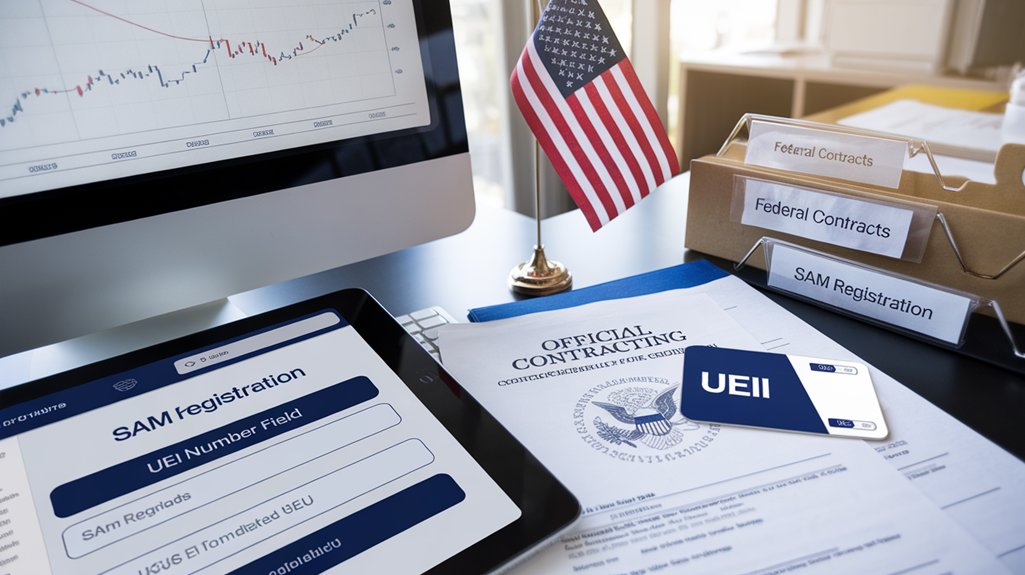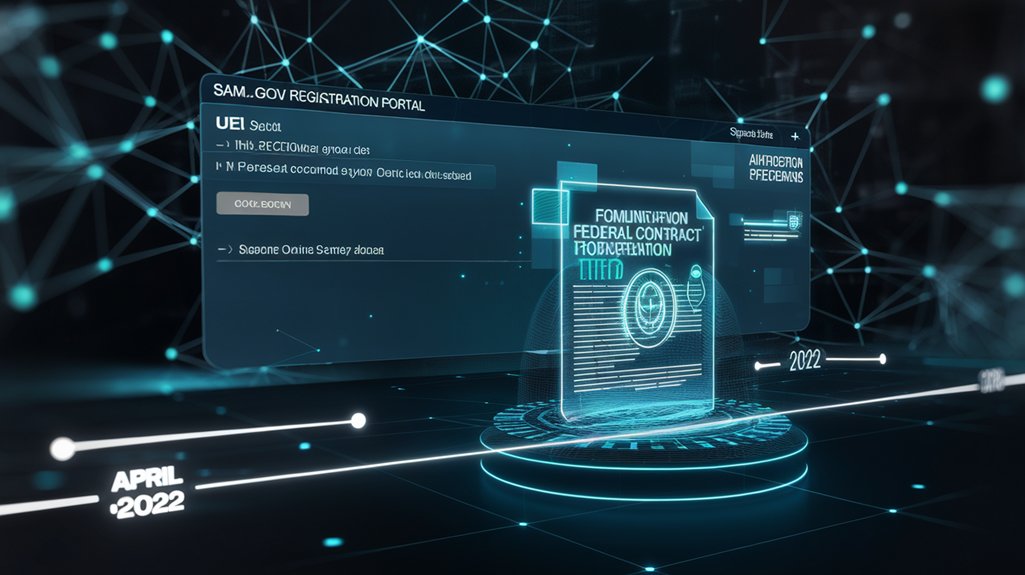The Unique Entity Identifier (UEI) is a 12-character alphanumeric code that replaced DUNS numbers in April 2022 for all federal contracting and grant activities. Entities must obtain a UEI through SAM.gov by creating a Login.gov account and completing registration, which typically processes within 7-10 business days. Registration is free and requires annual recertification to maintain eligibility for federal funding. The following sections explain how to navigate the UEI system effectively for federal contracting success.
What Is the UEI and Why It Replaced DUNS Numbers

The Unique Entity Identifier (UEI) represents a significant shift in how the federal government identifies its business partners. This 12-character alphanumeric code, issued directly by the General Services Administration through SAM.gov, has officially replaced the DUNS number system since April 2022.
One of the primary UEI benefits is the streamlined registration process, which eliminates dependency on third-party identifiers previously managed by Dun & Bradstreet.
The UEI differences from DUNS are substantial – the government now maintains complete control over the identification system, reducing costs and errors associated with external providers.
Entities previously registered with DUNS numbers received automatic UEI assignments during the changeover.
This government-led approach centralizes entity identification, creating a more efficient system for tracking federal contracts, grants, and awards.
The change supports the federal government’s ongoing efforts to simplify processes while maintaining robust identification standards for all contracting partners. New applicants seeking a UEI must now apply directly through SAM.gov rather than contacting Dun & Bradstreet. Customer support has been centralized with a single helpdesk for all UEI-related issues.
The transition to UEI enhances accuracy of identification across federal grant applications, benefiting organizations seeking government funding opportunities.
How to Obtain and Manage Your UEI in SAM.gov

Securing a Unique Entity Identifier (UEI) through SAM.gov involves several manageable steps that every federal contractor must complete before bidding on government opportunities.
The registration process begins by creating a Login.gov account, which serves as the gateway to SAM.gov’s services. After selecting the appropriate entity type, users must appoint an E-Business Point of Contact (EBiz POC) who oversees account management responsibilities. The UEI is a 12-digit number that has officially replaced the previously used 9-digit DUNS number. This transition was implemented to enhance security and improve overall data management for entities doing business with the federal government.
The system automatically generates a 12-character alphanumeric UEI upon successful registration verification. Most registrations take 7-10 business days to process, including IRS TIN matching and bank account verification steps.
Once active, entities must recertify annually to maintain compliance.
Account management becomes critical post-registration, as EBiz POCs must keep contact information current and monitor renewal deadlines.
The SAM.gov “Check Entity Status” tool allows organizations to verify their standing and guarantee uninterrupted eligibility for federal opportunities. It’s important to note that registration on SAM.gov is completely free and should be renewed annually to maintain access to federal funding opportunities.
UEI Implementation Timeline and Compliance Requirements for Federal Contractors

Federal contractors experienced a significant change on April 4, 2022, when the Unique Entity Identifier (UEI) officially replaced the previously used Data Universal Numbering System (DUNS) number for all federal contracting activities.
The 2022 UEI transition marked a pivotal shift in federal contractor identification requirements, streamlining the registration process through SAM.gov.
This alteration, mandated under 2 CFR Part 25, required all contractors to obtain their UEI directly from SAM.gov rather than through third-party providers like Dun & Bradstreet.
Despite some change challenges, contractor compliance became mandatory immediately upon implementation.
All Integrated Award Environment (IAE) systems, including FPDS, eSRS, FSRS, FAPIIS, and CPARS, were updated simultaneously to recognize UEI as the standard identifier.
This transition has streamlined the registration process for businesses seeking to participate in government contracting opportunities.
Federal contractors must:
- Register for a UEI through SAM.gov
- Update company profiles in E-Verify with their new UEI
- Maintain current UEI registration for all federal contracting activities
The federal government continues to monitor compliance while providing resources through SAM.gov to support contractors through this significant procedural change.
Frequently Asked Questions
Can State-Level Contracts Still Use DUNS Instead of UEI?
While federal contracts require UEI numbers exclusively since April 2022, state-level contracts technically can still use DUNS as an alternative identifier.
States maintain autonomy in their contracting systems and may continue using DUNS for purely state-funded projects.
However, any state contracts involving federal funds must use UEI numbers for compliance.
Organizations working with multiple government levels should maintain both identifiers, with particular attention to which identifier is required for state contracting in their specific jurisdiction.
How Does UEI Affect International Entities Doing Business With Federal Agencies?
International entities must obtain a Unique Entity Identifier (UEI) through SAM.gov to maintain federal eligibility when working with U.S. government agencies.
The free registration process requires foreign organizations to secure a NATO Codification System code (NCAGE) before completing SAM registration.
International compliance includes annual renewal requirements and documentation that may need certified translations.
Non-compliance risks contract termination or payment delays.
This requirement applies to all foreign cooperators receiving federal funds, regardless of location.
What Happens if There Are Discrepancies in Uei-Linked Data Across Systems?
Discrepancies in UEI-linked data across systems create significant business disruptions.
When data integrity issues occur, companies face payment delays that can exceed $400,000, contract ineligibility, and increased compliance risks.
System alignment failures typically stem from name inconsistencies, address mismatches, or documentation gaps.
Mitigation requires regular cross-system audits, validation protocols, and timely SAM profile updates within 10 days of any business changes, per FAR guidelines.
Are UEI Numbers Transferable During Mergers or Acquisitions?
During mergers or acquisitions, UEI numbers are not directly transferable between entities.
When acquisition processes occur, the acquiring company must update the entity registration in SAM to reflect the new organizational structure.
Mergers implications include the requirement to file proper documentation, including potential novation agreements for existing contracts.
The successor entity must guarantee all SAM registration information accurately reflects the post-merger organizational structure, ownership, and legal business name.
Do Subcontractors Need a UEI for Indirect Federal Contract Work?
Yes, subcontractors performing indirect federal contract work generally need a UEI. The requirement applies when:
- The subcontractor receives federal funds through a prime contractor.
- The subcontractor is specifically named in a federal contract.
- The prime contractor requires it for compliance purposes.
Subcontractor requirements for indirect work include SAM.gov registration to obtain a UEI, which guarantees proper tracking and reporting in federal systems.
This allows for regulatory compliance and verification of the subcontractor’s identity throughout contract performance.